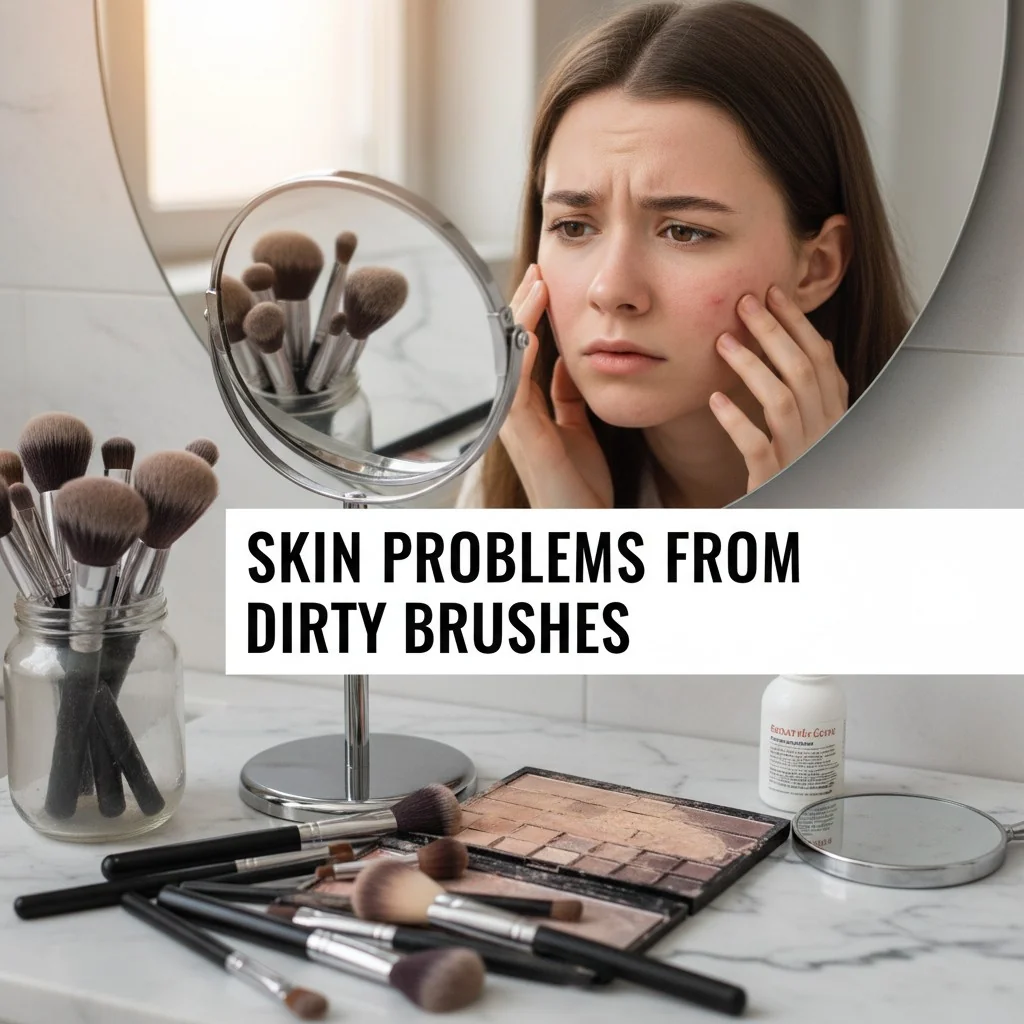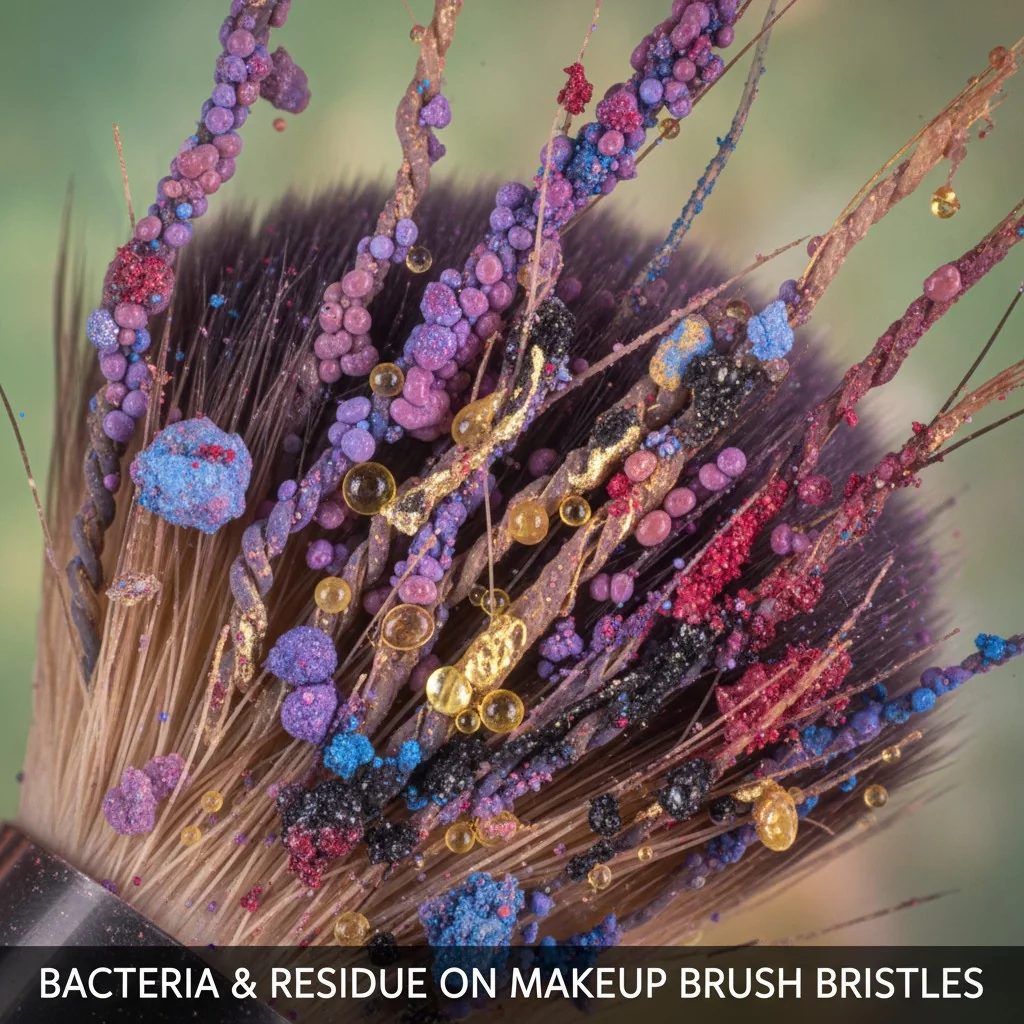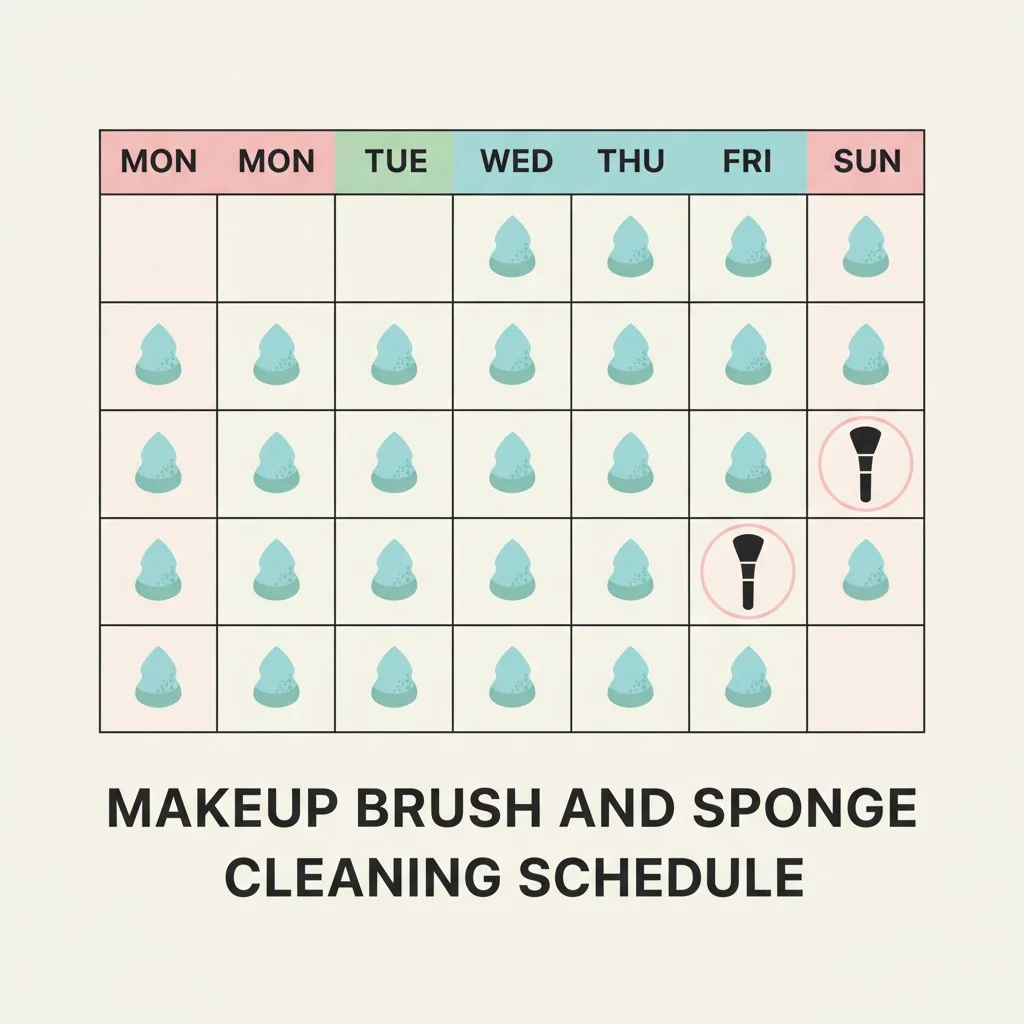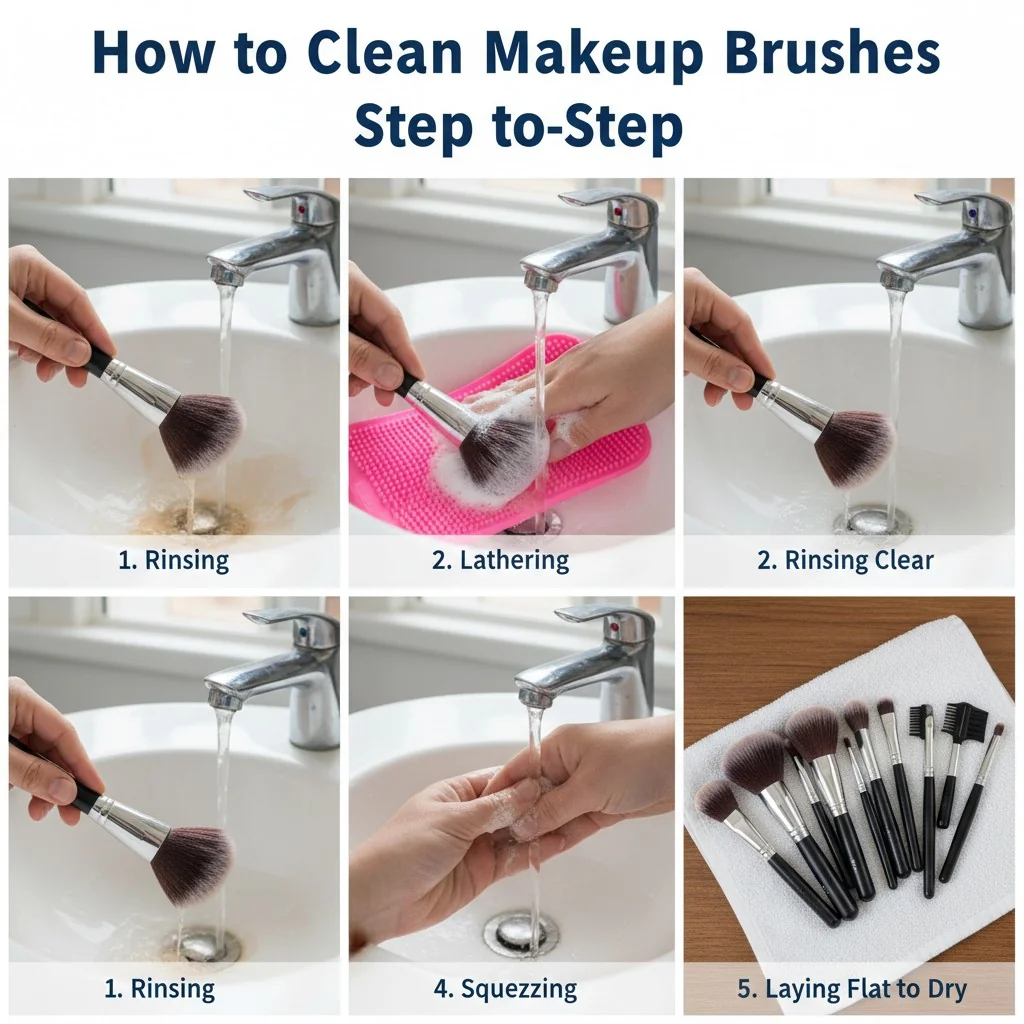Your skin is breaking out, and you can’t figure out why. Could your trusted makeup brushes be the secret culprit? Let’s find out what’s really going on.
Neglecting brush hygiene lets bacteria1, oils, and residue build up, causing acne, rashes, and infections (including staph and fungi). The American Academy of Dermatology advises washing makeup brushes every 7–10 days and cleaning sponges after every use to prevent this.
It’s one of the most common habits I see, both with makeup users and even new brands starting out—we invest in beautiful, high-performance tools but forget the most crucial step: maintenance. From my years on the factory floor to helping brands design their brush lines, I’ve learned that a brush is only as good as its care routine. The risks of skipping a wash are more than just streaky foundation; they directly impact your skin’s health and the longevity of your tools.
But don’t worry. I’m going to give you a clear, no-nonsense guide. We’ll look at what the science says, establish a simple cleaning schedule2, and I’ll even share some pro tips we give to brands at Brushino to help their customers. This is the definitive guide to stop your search and keep your skin happy.
Washing brushes once a month is enough to prevent bacteria growth.False
Bacteria can multiply to harmful levels in just a few days. The AAD recommends washing brushes every 7-10 days to effectively manage buildup and reduce infection risk.
Dirty makeup brushes can cause staph infections.True
Studies have identified Staphylococcus aureus (staph) on used cosmetic tools. This bacteria can cause skin infections, especially if the skin barrier is broken by a scratch or acne.
What Actually Builds Up on a Dirty Brush?
Your brush might look fine from a distance. But under a microscope, a thriving colony of grime is having a party in the bristles. I’ll show you what’s really hiding.
Dirty brushes collect a mix of old makeup, dead skin cells, natural skin oils, and moisture. This combination creates a perfect, nutrient-rich breeding ground for harmful bacteria like Staphylococcus3 and fungi, which can then be transferred back to your face with every use.
When I work with brands on material selection, we talk a lot about porosity and surface texture. Why? Because these factors determine how much stuff a brush holds onto. Every time you swipe a brush across your face, it picks up more than just product. It gathers everything on your skin’s surface. This creates a sticky, damp film that bacteria love.
The Unwanted Cocktail in Your Brush
Think of a dirty brush as a loaded petri dish. The main ingredients are:
- Sebum: Your skin’s natural oil. It’s a food source for bacteria.
- Dead Skin Cells: Everyone sheds them, and they get trapped in the bristles.
- Product Residue: Leftover foundation, concealer, and pigment build up, especially from cream and liquid formulas.
- Microbes: This is the biggest concern. Studies consistently find a zoo of bacteria.
Here’s a quick breakdown of what researchers typically find:
| Buildup Component | What It Is | Primary Risk |
|---|---|---|
| Bacteria | Staphylococcus, Micrococcus, E. coli | acne4, folliculitis, staph infections, eye infections |
| Oils & Sebum | Natural skin oils and product oils | Clogged pores, acne breakouts, food for bacteria |
| Dead Skin Cells | Keratinocytes shed from your skin | Dull skin, clogged pores, uneven makeup application |
| Product Residue | Old foundation, powder, pigments | Streaky application, skin irritation, contamination |
This bio-load, as scientists call it, gets worse with time and humidity. Storing brushes in a steamy bathroom is like turning on an incubator. This is why a simple cleaning routine isn’t just for looks—it’s a critical health habit.
Only brushes used for liquid foundation get truly dirty.False
While liquid products accelerate buildup, powder brushes also accumulate oils, dead skin, and bacteria from your face and can become just as contaminated over time.
Studies show 79-90% of used cosmetic products are contaminated with harmful bacteria.True
A 2020 study in the Journal of Applied Microbiology found high rates of contamination in everyday makeup products, highlighting the ease with which bacteria transfer from brushes to products and back.
How Often Should You Clean Each Tool?
You know you need to clean your tools, but the advice can be confusing. Is it weekly? Daily? It feels like a chore. I’ll give you a simple, expert-backed schedule.
The American Academy of Dermatology5 (AAD) gives a clear guideline: wash your makeup brushes every 7–10 days. However, makeup sponges must be cleaned after every single use because their porous structure traps significant moisture and product, creating a high-risk environment for bacteria.
Not all tools are created equal, and the product you use makes a big difference. When we develop brushes at Brushino, we consider how the material will interact with different formulas. This same logic applies to your cleaning schedule. A brush used for a light dusting of powder has a different risk profile than a sponge used to blend liquid foundation. Here is a clear, evidence-based cadence you can follow.
Your Definitive Cleaning Cadence
Use this table as your guide. It breaks down the rules by tool, product, and bristle type, so you’re never guessing again.
| Tool Type | Product Used | Recommended Frequency | Why? |
|---|---|---|---|
| makeup sponges6 | Any (Liquid, Cream, Powder) | After Every Use | Highly absorbent, traps moisture and product, creating a perfect bacterial breeding ground. |
| Foundation/Concealer Brushes | Liquid or Cream | Every 3-5 Days (or weekly) | Liquid formulas create a damp, sticky environment that bacteria love. Clean more often if you’re acne-prone. |
| Powder/Blush/Bronzer Brushes | Powder | Every 7-10 Days | Powders are drier, so risk is lower, but oils and skin cells still build up. |
| Eyeshadow/Eyeliner Brushes | Any | Every 7 Days (Strictly) | The eye area is extremely sensitive to infection. Never share these tools. |
| Natural Hair Brushes | Liquid or Cream | Every 5-7 Days | Natural bristles are more porous and absorb oils and pigments, requiring more frequent deep cleaning. |
| Synthetic Hair Brushes | Liquid or Cream | Every 7-10 Days | Synthetic filaments are less porous and easier to spot-clean, but still need a weekly deep wash. |
As a manufacturer, I can tell you that natural hair is fantastic for blending powders, but its structure means it holds onto oils tightly. If you use natural brushes for creams, you must be extra diligent. For brands, this is a key piece of aftercare information to provide your customers.
You only need to wash makeup sponges once a week.False
The AAD and microbiologists strongly recommend washing sponges after each use. Their porous, damp environment allows bacteria to multiply to over 1 million CFU/ml, posing a significant health risk.
Brushes used for powder products can be cleaned less frequently than those used for liquids.True
Liquid and cream products introduce more moisture and oils, which accelerates bacterial growth. Therefore, brushes used with these formulas require a stricter cleaning cadence.
What Are the Dermatologist-Approved Cleaning Steps?
You’re ready to wash your brushes, which is great! But washing them the wrong way can be ineffective or, worse, damage the tools you’ve invested in. Let’s do it right.
Gently wash brush tips with lukewarm water and a mild shampoo. Swirl the bristles in your palm, rinse until the water runs clear, carefully squeeze out excess moisture, and lay them flat to dry with the bristles hanging over an edge to protect the glue.
Over the years, I’ve seen so many beautiful brushes ruined by improper care. The most common mistake? Drying them upright in a cup. Water seeps down into the ferrule (the metal part) and dissolves the glue that holds the bristles. The brush starts shedding, and the handle can even come loose. Here is the simple, safe method recommended by dermatologists, plus some pro tips we share with salons and brands.
For Your Personal Kit: The AAD Method
This is the gold standard for at-home cleaning. It’s gentle, effective, and protects your brushes.
- Rinse: Wet the bristle tips under lukewarm running water. Avoid getting the handle and ferrule wet.
- Wash: Place a drop of gentle shampoo or a dedicated brush cleanser into the palm of your hand. Gently swirl the brush tips in the cleanser to create a lather.
- Rinse Again: Rinse the bristles under lukewarm water until the water runs completely clear.
4s. Squeeze: Gently squeeze out the excess water with your fingers or a clean towel. Reshape the brush head. - Dry: Lay the brush flat on a towel with the bristles hanging off the edge of the counter. This allows air to circulate and prevents water from damaging the ferrule.
For Brands & Salons: Pro-Level SOPs
For my B2B clients, hygiene isn’t just personal—it’s a business standard. Cross-contamination is a major risk. Here are the Standard Operating Procedures (SOPs) we recommend:
- Per-Client Sanitation: For quick turnarounds with powder products, use a 70% isopropyl alcohol spray to disinfect bristles between clients. Always have multiple brush sets to rotate, allowing one set to fully dry while another is in use.
- End-of-Day Deep Clean: This is non-negotiable. All brushes must undergo a deep clean using the method above with a professional-grade cleanser. Use dedicated drying racks to ensure proper airflow and shape retention.
- Brand Aftercare Education: We strongly advise brands to include a cleaning guide with their brush kits. A simple card or a QR code linking to a video (like this guide!) adds immense value. It reduces customer complaints about "skin irritation," builds brand trust, and supports your quality claims.
You should dry your makeup brushes standing upright in a cup.False
Drying brushes upright allows water to seep into the ferrule, where it can dissolve the glue and loosen the bristles, causing the brush to shed and fall apart.
Including a cleaning guide with brush sets can improve customer satisfaction and reduce returns.True
Educating customers on proper aftercare helps them achieve better results and maintain the brush's quality, which enhances brand equity and reduces complaints related to poor hygiene or brush damage.
What Does the Data Show About Brush Contamination and Habits?
You hear that dirty brushes are bad, but how bad are they really? The numbers from scientific studies are genuinely shocking and confirm this isn’t just a myth.
Scientific studies are alarming: 79–90% of in-use cosmetic products are contaminated with dangerous bacteria. One study found 93% of beauty blenders were never cleaned and harbored over a million bacteria per milliliter, including E. coli and Staphylococcus.
As someone who geeks out on product quality, I always go to the data. The gap between knowing we should clean our brushes and actually doing it is where the danger lies. The evidence is overwhelming and shows a direct link between poor hygiene habits and high levels of contamination. Let’s look at the hard facts from two key studies.
The Shocking Numbers Behind Dirty Tools
A 2020 study from Aston University published in the Journal of Applied Microbiology gave us some of the most cited figures in the industry. Another study from 2025 in the International Journal of Microbiology looked specifically at user habits7.
| Study Finding | The Data | What It Means for You |
|---|---|---|
| product contamination8 | 79-90% of all used products (lipstick, gloss, liners, mascara) were contaminated. | Your brushes are picking up bacteria and putting it back into your products, creating a cycle of contamination. |
| Beauty Blender Contamination | Averaged >10^6 CFU/ml (Colony-Forming Units per milliliter). | That’s over a million bacteria in a single sponge. For context, that’s a level considered unsafe in many contexts. |
| User Habits (Sponges) | 93% of beauty blender users admitted they had never cleaned it. | This behavior directly explains the extreme levels of contamination found. |
| User Habits (Brushes) | 44.3% of users reported they "rarely" clean their brushes. | Nearly half of users are at high risk for the skin issues caused by dirty tools. |
| Reported Skin Issues | 27.8% of users reported skin problems they believed were linked to their tools. | This shows a clear, perceived link between dirty brushes and negative health outcomes like acne and rashes. |
This data is why we at Brushino are so passionate about educating brands. When you sell a brush, you’re also selling a responsibility. Providing clear, simple aftercare instructions isn’t just good customer service—it’s a public health service that protects your customers and elevates your brand.
Beauty blenders are cleaner than brushes because they are used wet.False
The opposite is true. The dampness of a beauty blender makes it a more potent incubator for bacteria and fungi. Studies show they are often the most contaminated tool in a makeup bag.
Nearly half of all makeup users rarely clean their brushes.True
A 2025 study found that 44.3% of users admit to rarely cleaning their cosmetic brushes, putting them at a higher risk for skin infections, acne, and other hygiene-related issues.
Conclusion
Cleaning your brushes is not just about better makeup application; it’s a fundamental part of a healthy skincare routine. A simple, consistent habit protects your skin and your tools.
References
-
Understanding the role of bacteria in makeup brushes can help you maintain better hygiene and skin health. ↩
-
Discover a practical cleaning schedule to keep your brushes and skin healthy. ↩
-
Find out how this bacteria can affect your skin and why cleaning brushes is essential. ↩
-
Learn how unclean brushes contribute to acne and what you can do to prevent it. ↩
-
Explore expert recommendations for brush cleaning to protect your skin. ↩
-
Learn the importance of cleaning sponges after each use to prevent bacterial growth. ↩
-
Learn about common habits that can lead to skin issues and how to improve them. ↩
-
Explore the dangers of using contaminated products and how to avoid them. ↩







